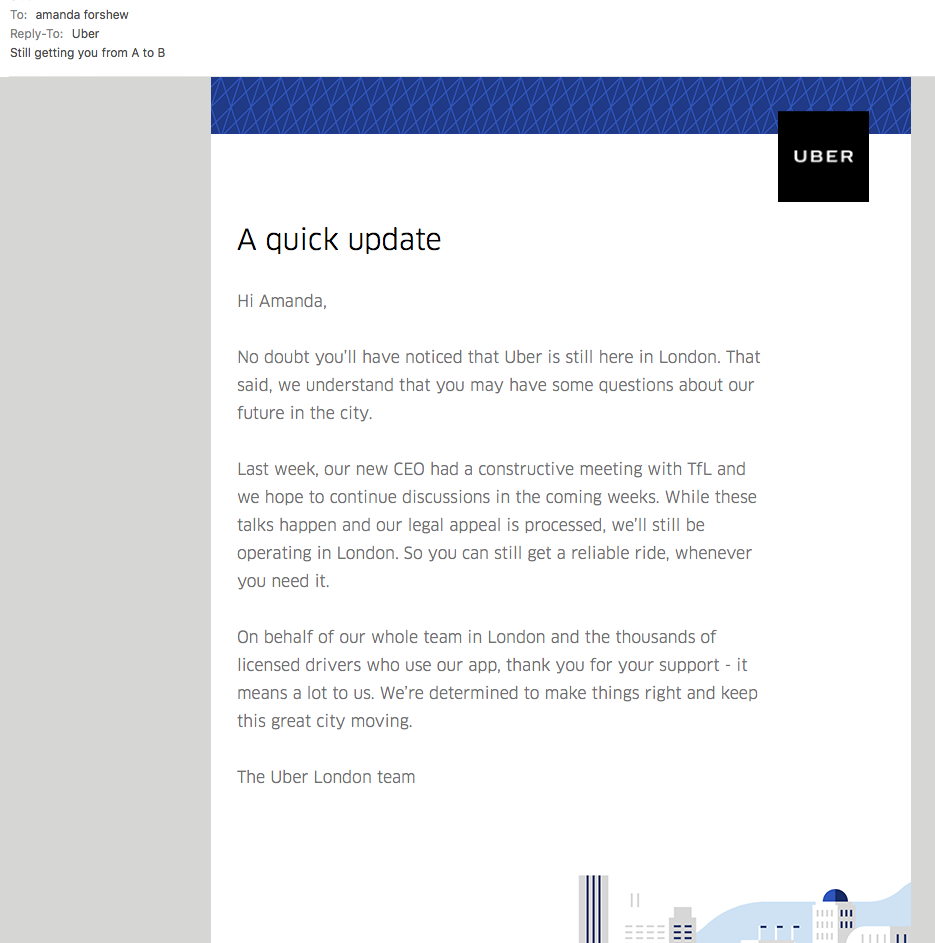
I read a quote somewhere from Skip Prichard (CEO & Leadership speaker):
“Clarity is the beginning of a good experience.”
We see time and time again where a lack of clarity or expectation management, has led to pain points in the customer journey.
One case in point where I have seen this recently is with Uber. Uber is publicly having a torrid time in the UK right now but it has deliberately set out to engage customers through this time of uncertainty.
Uber is important to the population of London. There are 3.5 million customers who are ferried around by 40,000 drivers. Uber has made travelling around London easier and (arguably) better value. Customers are empowered and are in more control of their mobility choices with Uber – love it or loathe it.
TfL commented the other week that Uber was not a “fit and proper” private car-hire operator and cited four areas of concern. These included its approach to reporting criminal offences and carrying out background checks on drivers. The main concern appears to be one of safety. As a customer, I would argue that we feel safer with Uber because of the ability to track journeys and engage with drivers.
Thankfully for customers such as me, who have become reliant on Uber, the company has embarked on a legal battle to overturn this decision and to retain their London licence.
According to a recent article in The Standard, Londoners could end up paying an extra £90 million a year in black cab fares if Uber’s appeal is unsuccessful.
Dara Khosrowshahi, who succeeded Uber founder Travis Kalanick as CEO a month ago, has admitted that mistakes have been made, that they will learn from these mistakes and improve, but that they will challenge the decision so that they can continue this service to its customers.
I am not arguing about the rights and wrongs of TfL’s decision. It would seem fair that Uber must comply with the same regulations as other taxi companies in London but I, for one as an Uber customer, value the new-found freedom and flexibility that it offers (normally at a better price).
Many Uber customers feel strongly too about this case. There is now an Uber petition which had 855,342 supporters when I last looked.
I received an email from Uber 10 days ago. It was sent to me as a customer – by name. Okay that element of personalisation is incredibly easy. What’s interesting though is how Uber is managing this event and the process of proactive engagement with its customers rather than letting the story be told elsewhere. It is choosing to connect with its customers in a relatively simple and low effort way but all the same, has taken back control and the lead. It makes me feel like a member of an Uber club or community, fighting for our rights as Londoners to be able to use this service.
Here is the email which had the subject line: Still getting you from A to B.

So, the email was a friendly, informative, reassuring, positive and dare I say it, thoughtful interaction with me as a customer. Uber had taken the time to clarify the situation. Those cynics amongst us will say it’s all about business continuity, but at the end of the day it is managing customers’ perceptions and expectations which are crucial in customer experience management.
Basic tips for when things don’t go to plan or you are feeling on the back foot? Take advantage of the situation and flip it from negative to positive – see it as an opportunity to engage with your customers.
• Make it personalised and positive
• Don’t blame or defend
• Acknowledge the problem
• Take ownership and remove customer effort
• Give a sense of action and commitment
• Be authentic and human
• Keep to the basics and keep it simple
• Provide reassurance, give confidence and be in tune with customers’ likely emotions
• Map out the right information to be delivered at the right time
• Empower frontline employees to engage with customers
• Provide employees with the tools and guidance to be able to do this
Interestingly, I noticed that one organisation with whom I have personally encountered a poor experience during service disturbance, recently advertised online for a new role of ‘Disruption Communications Officer’.
Avoidance of contact (particularly in times of disruption or issue) gets companies nowhere, nor does shying away from problems – I can think of quite a few train and plane operators here.
Customers appreciate honesty and transparency. They value companies who inform, guide and alleviate their own concerns. Make for Happy Customers by telling the story before the story becomes you.



